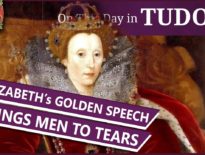On this day in Tudor history, 29th November 1528, nobleman and courtier, Anthony Browne, 1st Viscount Montagu, was born.
Montagu began his court career with the help of his father in Henry VIII's reign. served as a privy councillor in Mary I's reign, and died a natural death as a wealthy man in Elizabeth I's reign. He even survived being implicated in a rebellion!
Who was Anthony Browne, 1st Viscount Montagu, and just how did he manage to not only have an excellent court career, but leave a fortune to his grandson, when he was a Catholic in Elizabeth I's reign?
Find out all about him in today's talk.
Also on this day in Tudor history, 29th November 1530, Cardinal Thomas Wolsey, Henry VIII’s former Lord Chancellor, died at Leicester Abbey. The cardinal cheated the executioner by dying a natural death while on his way to London to answer charges of treason. You can find out about Cardinal Wolsey's death, and who ended up being buried in the sarcophagus he'd had commissioned in last year’s video:
Also on this day in history:
- 1593 – Execution of Richard Hesketh, merchant, at St Albans for treason. Hesketh had incited Ferdinando Stanley, the new 5th Earl of Derby, to lead a rebellion to claim the throne by right of his descent from Mary Tudor, sister of Henry VIII.
Transcript:
On this day in Tudor history, 29th November 1528, nobleman and courtier, Anthony Browne, 1st Viscount Montagu, was born.
Montagu was prominent in Mary I’s reign, with his offices including Master of the Horse to Philip of Spain, Lord Lieutenant of Sussex and Privy Councillor.
Let me give you a few facts about this Tudor man…
• Anthony was the eldest son of Sir Anthony Browne of Cowdray Park, Sussex, and his first wife, Alice, daughter of Sir John Gage.
• His father had been so trusted by King Henry VIII that he had held a dry stamp of the king’s signature. His aunt, Elizabeth, Countess of Worcester, was one of Anne Boleyn’s ladies, and, according to Lancelot de Carle, made allegations about the queen’s behaviour with Mark Smeaton and her own brother.
• In 1545, when he was just 16, Anthony served as Member of Parliament for Guildford, in Surrey, due to his father’s influence, and was joint standard bearer of England with his father in 1546. He went on to serve as equerry of the stable, under his father as Master of the Horse, in early 1547, and was created a Knight of the Bath in Edward VI’s coronation celebrations in February 1547.
• Anthony married when he was about 18, in 1546, taking Jane Radcliffe, daughter of Robert Radcliffe, Earl of Sussex, as his wife. They had a son, Anthony and a daughter, Mary. Jane sadly died in July 1552.
• Following his father’s death in 1548, Anthony lost his position as standard-bearer. He had been brought up a Catholic and supported Princess Mary during Edward VI’s reign, so was not given any important offices. However, he did serve as an MP for Guildford and then Petersfield, and sheriff for Surrey and Sussex.
• During the succession crisis of July 1553, he did nothing to support Queen Jane, or Lady Jane Grey, and he went on to rise in Mary I’s reign.
• He was appointed keeper of Guildford Park in October 1553, and then in 1554, steward of Hampton Court chase and a Justice of the Peace for Surrey and Sussex.
• In 1554, he was appointed as Philip of Spain’s Master of the Horse, but on his arrival in England, Philip chose to replace Anthony and other Englishmen with Spaniards. However, as part of the celebrations for Mary and Philip’s wedding in 1554, he was made Viscount Montagu and then, in 1555, elected as a Knight of the Garter.
• In 1555, Anthony was also sent as an ambassador to Rome to talk to the pope about Mary’s restoration of Catholicism in England.
• In 1556, Anthony married his second wife, Magdalen Dacre, daughter of William Dacre, 3rd Baron Dacre. The couple went on to have 8 children: 5 sons and 3 daughters.
• In 1556, he also acted as an executor of the will of Stephen Gardiner, Bishop of Winchester and Mary’s Lord Chancellor, and also as chief mourner.
• In 1557, Anthony served as lieutenant-general under William Herbert, 1st Earl of Pembroke, at Calais and the Siege of St Quentin, and was appointed to the queen’s privy council.
• Mary I died in November 1558 and Anthony was one of the executors of her will and acted as a chief mourner at her funeral.
• As a Catholic conservative, Anthony was relieved of his position on the privy council on the accession of Elizabeth I and he went on to oppose Elizabeth’s plans for religious reform in 1559. Personally, however, he did manage to keep on the right side of the new queen, and acted in a diplomatic capacity for her in Spain in 1560 and 1565, and to the Low Countries in 1565.
• By the 1560s, Anthony was a wealthy man, with an annual income of between £2000-3000.
• In 1569, at the time of the Rising of the North, he acted as joint Lord Lieutenant of Sussex, but he and his son-in-law, Henry Wriothesley, 2nd Earl of Southampton, did become implicated in the rebellion and even set sail for Flanders, being driven back by wind. However, they went unpunished.
• In 1570, Southampton was arrested and confined to the home of the Sheriff of London after having a secret meeting with the Scottish Bishop of Ross, following Elizabeth I’s excommunication. In 1571, he was also implicated in the Ridolfi Plot. However, Anthony was not caught up in it. Southampton was released and allowed to reside at Cowdray House with his father-in-law in 1573.
• In 1585, when trouble began with Spain, Anthony was removed from his office of Lord Lieutenant, but in 1586 he was appointed as one of the commissioners for the trial of Mary, Queen of Scots.
• In 1588, he supported his queen against the Spanish Armada by leading horsemen, aided by his son, Anthony, and grandson, Anthony-Maria.
• In August 1591, he played host to Queen Elizabeth I fro six days at his estate at Cowdray, and the queen knighted his second son, George, and his son-in-law, Robert Dormer.
• Anthony Browne, 1st Viscount Montagu, died at his manor of West Horsely in Surrey on 19th October 1592 following what was described as a “tedious, troublesome, and lingering kind of infirmity.” He was 63 years of age. His grandson, Anthony Maria Browne was his heir, inheriting a large fortune worth between £3600 and £5400 per year.
• On 6th December 1592, Anthony was laid to rest at Midhurst, but was moved to St Mary’s Church in Easebourne, Sussex in the 19th century. His tomb is marble and alabaster, and is topped with a kneeling effigy of Anthony and recumbent effigies of his wives. His second wife died in 1608.



Leave a Reply